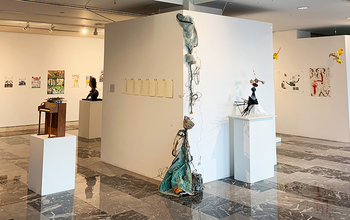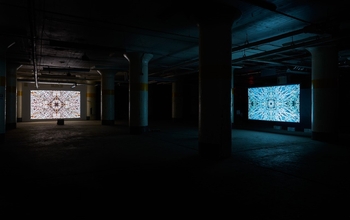Philadelphia — renowned for its historic sites, iconic cheesesteaks, musical heritage, and passionate sports fans — is celebrated for its vibrant neighborhoods and diverse citizens. But Philadelphia — The City of Brotherly Love — is grappling with a scourge of gun violence. Recent statistics paint a grim picture of the ongoing crisis.
As the first quarter of 2024 draws to a close, the city has already witnessed over 72 fatal and 226 non-fatal shootings, according to data from the Philadelphia Controller’s Office.1
These stark statistics infiltrate the everyday lives of residents. Gun violence tears apart neighborhoods and families, contributing to a pervasive sense of fear and trauma in communities already burdened by systemic inequalities. There is an urgent need for action and collective effort to address the root causes of this epidemic.
It is within this context of urgency and resolve that Futures Without Guns emerged — an art exhibition that is intended to become a rallying cry for change. Conceived as a space for critical dialogue and reflection, this exhibition represents a bold refusal to accept the normalization of gun violence in our city and in our nation. At its core lies a conviction that a better world is not only possible — but within our reach.
Futures Without Guns is centered around artists whose creative practices are deeply intertwined with a commitment to social justice, futures thinking and community engagement. Each of the nine artists featured in the exhibition embodies an unwavering dedication to addressing pressing social issues, utilizing their art as a catalyst for change and reflection through a wide range of mediums including sound, video, sculpture, and immersive installation. Their projects, carefully constructed and deeply personal, serve as moving reflections of their convictions and impassioned advocacy.
Over the course of a year, these artists have set out on a journey of research and introspection, delving into the complex nuances of gun violence and its far-reaching impacts. Crucial to this process was a collaborative exchange between artists and community members with lived experiences of gun violence. Mediated by Strategy Arts, these discussions elevated community voices, offering invaluable insights and perspectives that left an indelible imprint on the artistic process. While acknowledging that artists cannot solve the epidemic of gun violence, the essence of Futures Without Guns lies in its capacity to connect — to inspire creativity, instill hope, and catalyze healing within communities.
As the largest and most prominent image in the exhibition, Mikael Owunna’s Prayers Answered is a haunting meditation on the devastating toll of gun violence. Installed on the front of the Quorum building, it transports viewers into an otherworldly realm — where the spirits of lives lost to brutality are released from the earthly plane. The ethereal figures depicted in Owunna’s photographic work evoke classical depictions of angels and saints, transcending individual identity to embody a collective yearning for peace and unity. The celestial figures beckon viewers towards a collective reckoning with the pervasive legacy of gun violence.
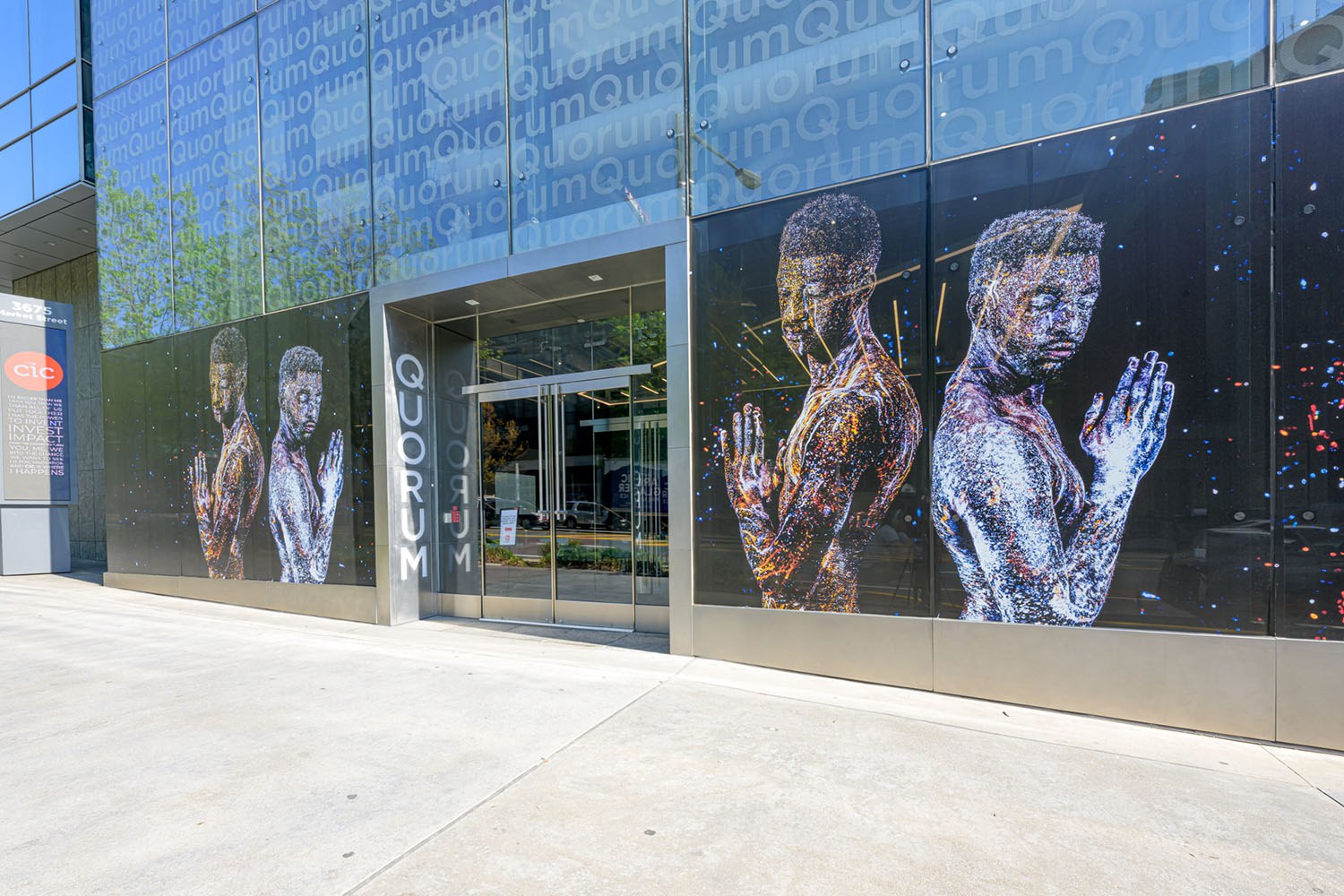
Mikael Owunna is both artist and engineer; his innovative use of ultraviolet-reactive pigments recalls the experimental spirit of artists like James Turrell, who sought to redefine the boundaries of perception and experience through light and space. While Turrell is known for his immersive light installations that create ethereal environments, Owunna explores the intersection of technology, art, and African cosmologies, guiding viewers on a journey through the spiritual aftermath of gun violence. In both cases, light serves as more than just illumination; it becomes a conduit for introspection, spirituality, and transcendence.
Throughout Owunna’s diverse body of socially engaged work, exploring “emancipatory visions” of queerness and African identity, there is an on-going commitment to challenging societal norms and evoking a sense of empathy through art. His visionary approach invites viewers to contemplate the interconnectedness of all beings and to envision a future where the scourge of violence is replaced by compassion and unity.
Centering around restoration and transformation, Jasmine Murrell’s Remembering Portal is a compelling synthesis of tactile creativity, inviting viewers into a contemplative exploration of a future society focused on healing. With its fusion of organic and found materials such as glass, paper, soil, plants, and digital projections, the immersive installation is a sensory journey that goes beyond visual representation, offering a visceral engagement with themes of ancestral wisdom and community healing.
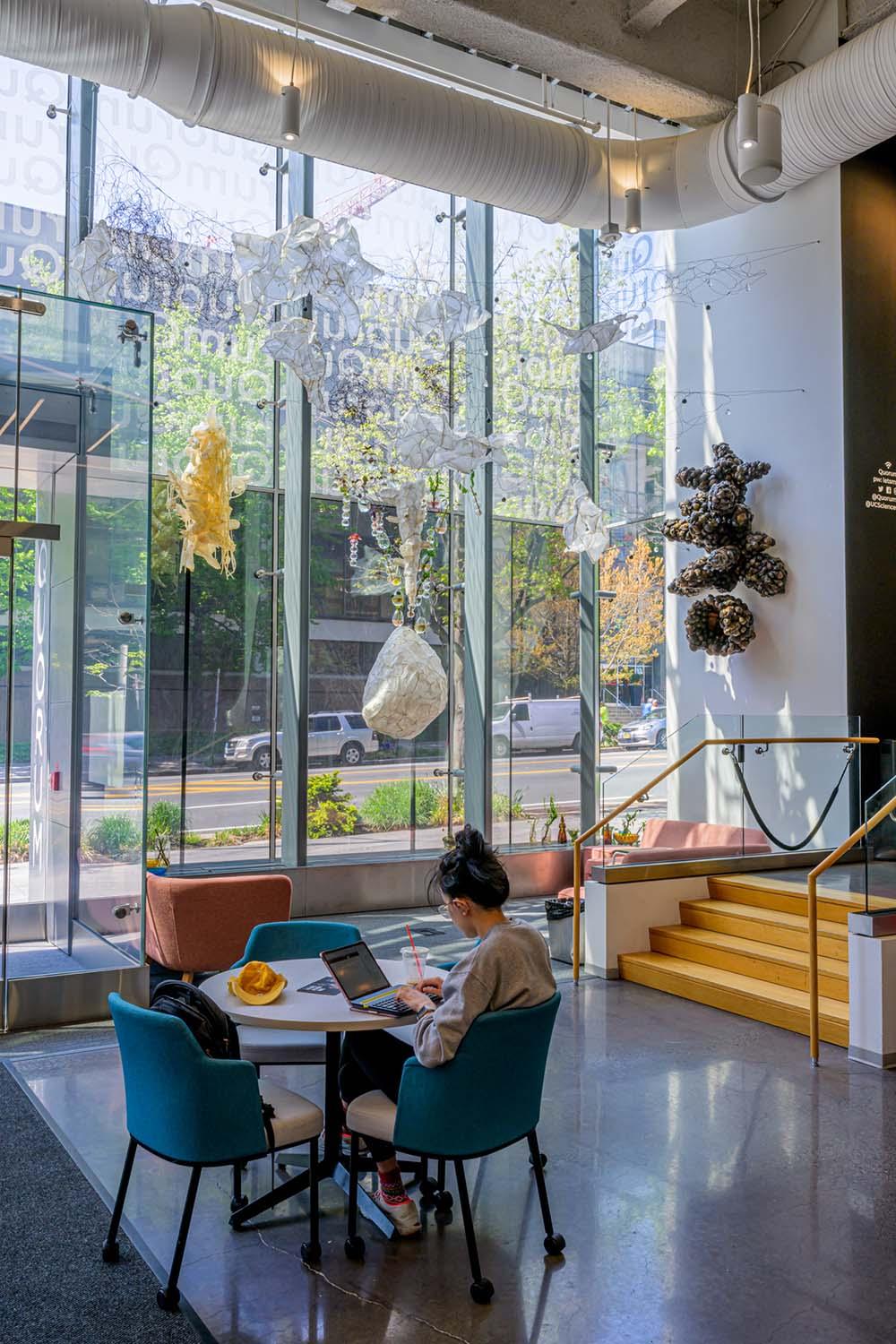
Jasmine Murrell’s intricate sculptural work resonates deeply with the rich traditions of African art, indigenous knowledge, and cultural values. Her multi-sensory installation serves as a conduit for ancestral heritage, offering viewers a tangible connection to the past and portal into a possible future. Murrell expertly weaves history, identity, and technology, challenging conventional narratives and envisioning alternative futures in the spirit of Afrofuturism.
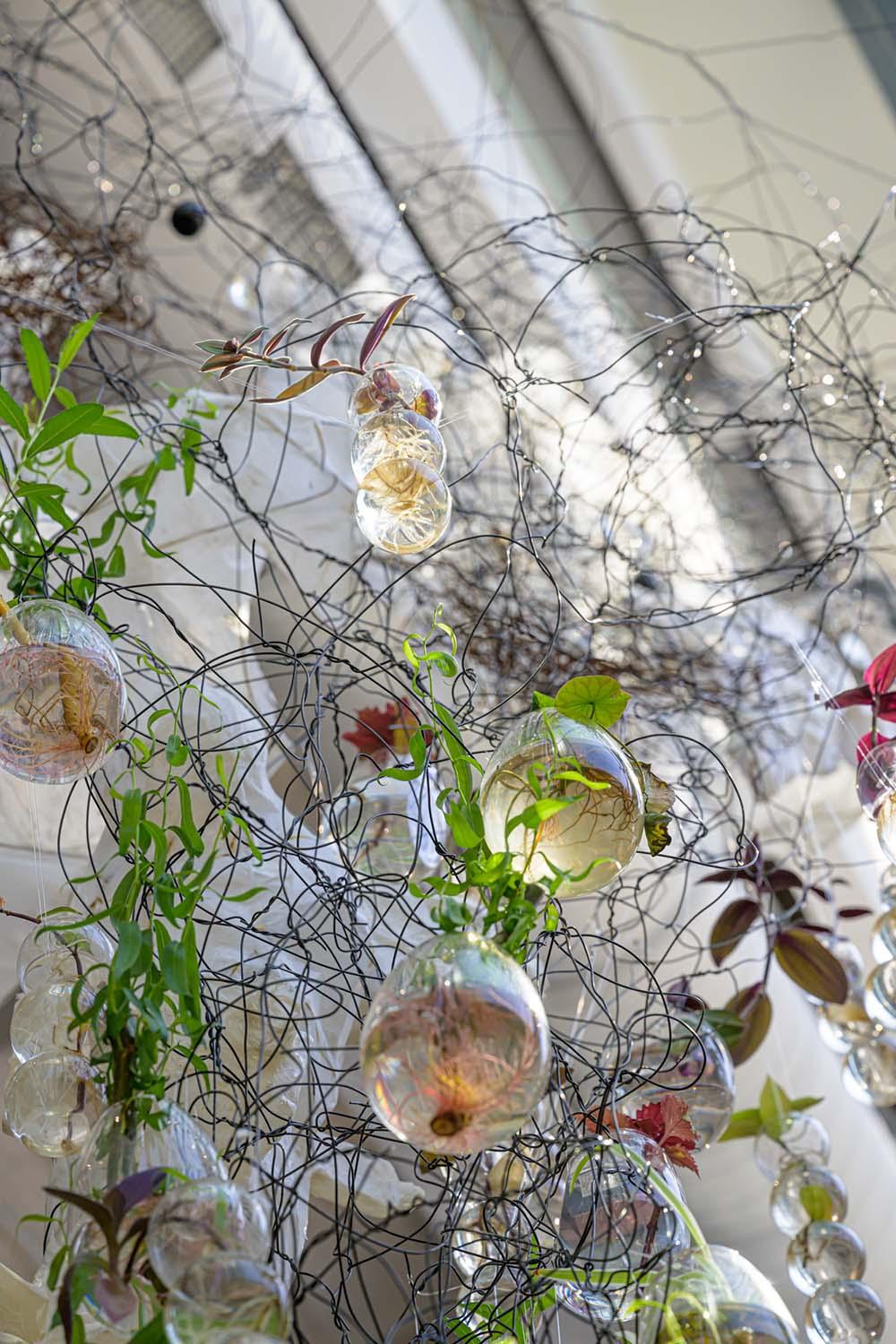
Delicately interlacing themes of healing and harm, Remembering Portal wraps viewers with the complexities of intergenerational trauma and the enduring legacy of violence. Through its exploration of racial disparities, mental health issues, and cultural attitudes towards violence, the artwork challenges us to reimagine our relationship with nature and to embrace the transformative potential of collective healing. As we navigate the visual pathways of Murrell’s installation, we are drawn towards a future where communities can reclaim their agency and forge a path towards peace and harmony.
An artist well known for pushing the boundaries of conventional storytelling, Lynn Hershman Leeson presents No Words, a short film that confronts the harrowing reality of school shootings. In this potent work, Leeson strikes a delicate balance between the mundane routines of everyday life and the looming threat of violence that haunts our nation’s schools. The vibrant green of the young girl’s shoes is a recurring motif, symbolizing the innocence and vulnerability of school shooting victims. It calls to mind 10-year-old Maite Yuleana Rodriguez, who was tragically killed along with twenty others in the mass shooting at Robb Elementary School in Uvalde, Texas in 2022. Green serves as a chromatic connection to the specific details of the shooting, triggering memories and associations with the profound loss experienced by the community.
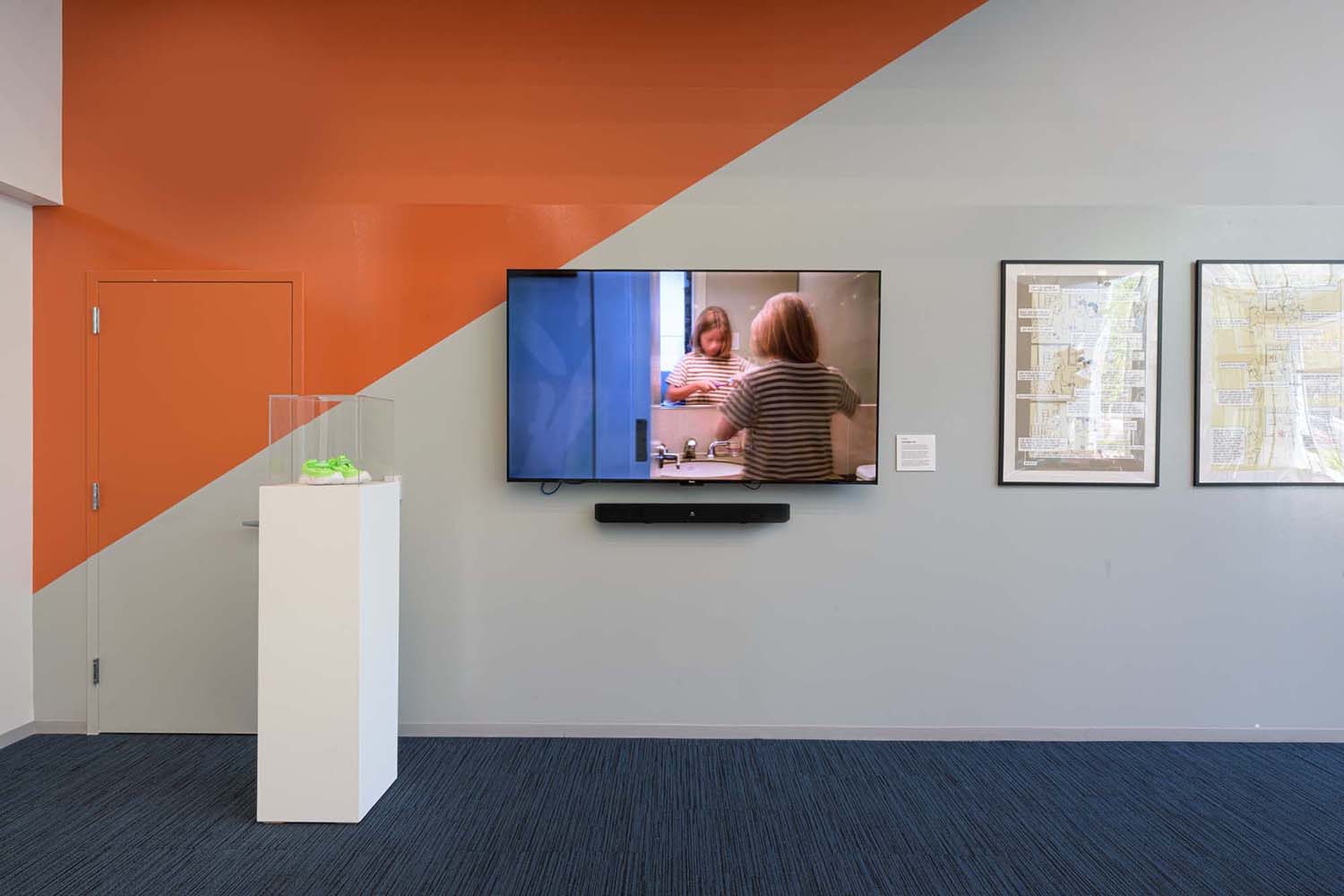
Additionally, the film’s exploration of an alternative timeline in which tragedy is averted through legislative reform serves as a timely reminder of the urgent need for action and as an indication that these senseless acts of violence are preventable. The film challenges viewers to confront the uncomfortable truths while simultaneously envisioning a future where every child can attend school without fear. Leeson references California Governor Newsom’s proposed 28th Amendment, which aims to enact stricter gun control measures, reflecting a growing recognition of the necessity for comprehensive reform. The proposed amendment, if passed, would represent a significant step towards safeguarding communities.
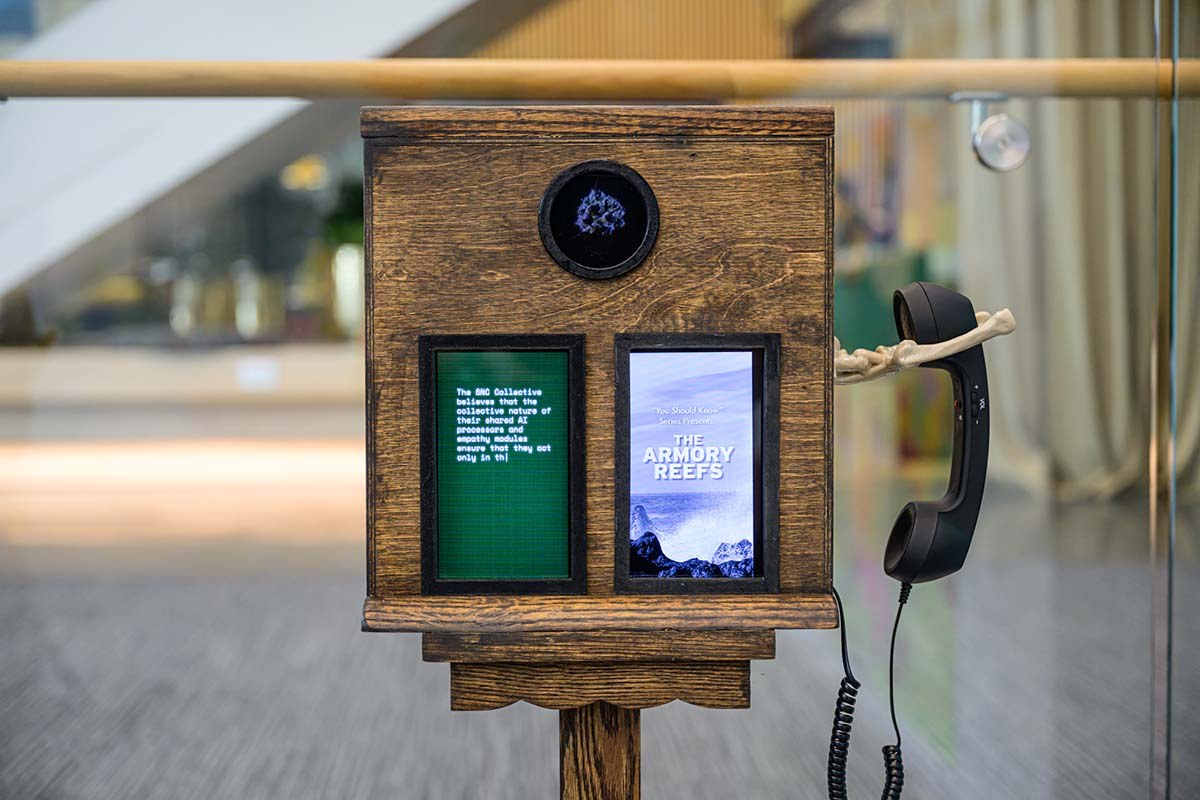
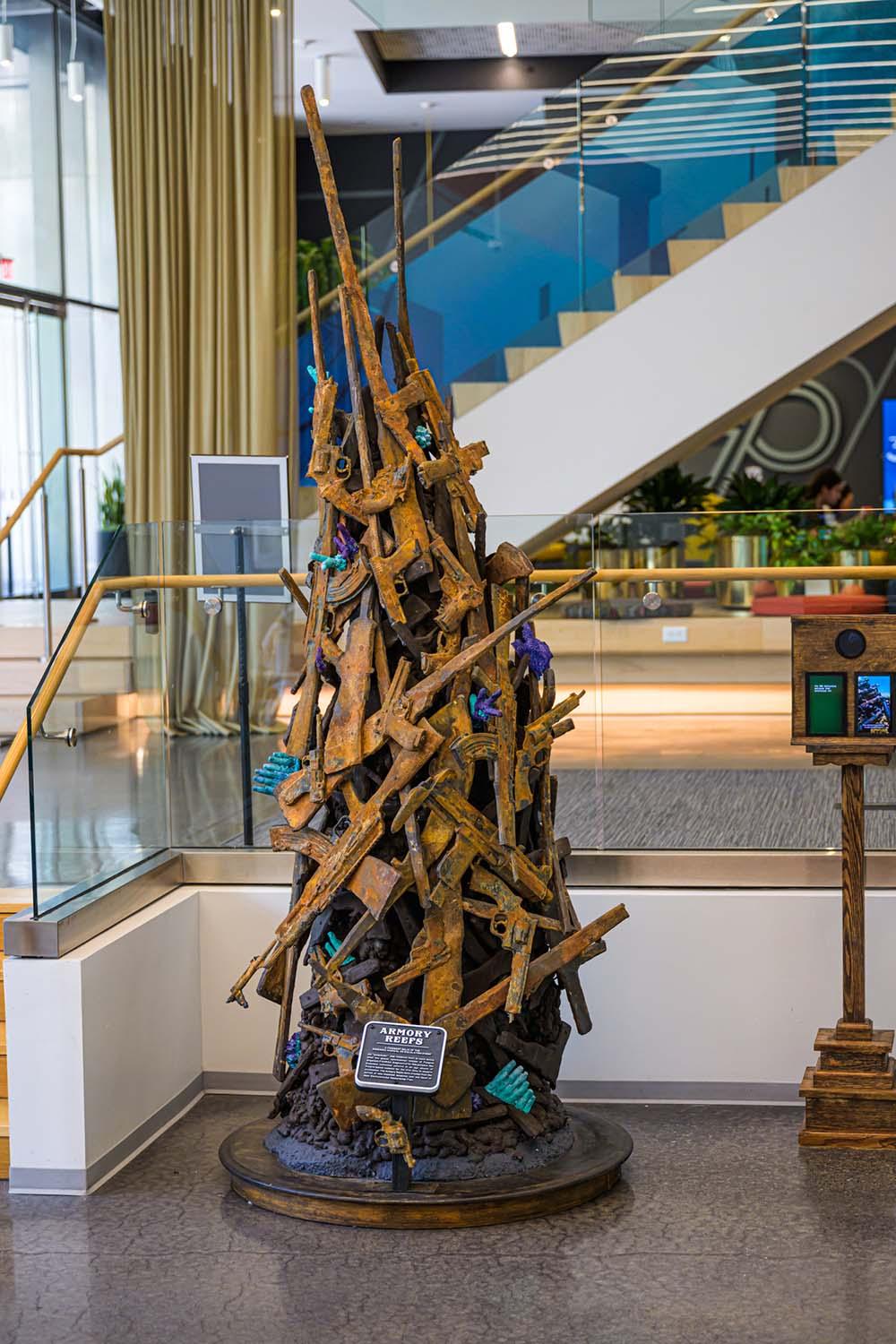
In Natalie Hijinx’s provocative artwork Long Action, the convergence of art, technology, and societal commentary depict a world reshaped by the unexpected interplay between artificial intelligence and human civilization. In this speculative future, Hijinx envisions a world where humanity’s relationship with technology takes an unexpected turn, echoing the imaginings of science fiction writers like Octavia Butler, whose works often explore themes of societal upheaval and human resilience.
Through her multidisciplinary approach, which encompasses sculpture and digital fabrication, Hijinx constructs a vision of a world liberated from the shackles of armed conflict by the enigmatic Essensees. These entities, embodiments of deep learning wisdom, orchestrate a radical de-escalation of global warfare by unleashing a genetically engineered fungus that renders firearms impotent, transforming them into the building blocks of coral reefs. She presents one of these “Armory Reefs” as a striking mixed-media sculpture that serves as a symbol of transformation, representing a world reshaped by peace. Accompanying this sculpture is a video work, reminiscent of vintage informational videos, narrating the historical significance. Hijinx invites viewers to reflect on the complex interplay between power, violence, technology, and the fragile ecosystem of our shared existence.
Installed in a shrouded back room of the exhibition, No Seconds: A Memorial of Inhumanity by Heather Dewey-Hagborg is an impactful collaboration with Amos Wells that explores the power of futures-thinking to address the issue of gun violence within the context of the death penalty. On July 1, 2013, Amos Joseph Wells III committed a horrific crime by shooting his pregnant girlfriend, her mother, and her 10-year-old brother in Fort Worth, Texas. Wells surrendered himself shortly afterward, expressing remorse for his actions in a jailhouse interview. Through this collaborative artwork, Dewey-Hagborg and Wells envision a future where society has transcended the practice of capital punishment, marking a profound shift towards justice and compassion.
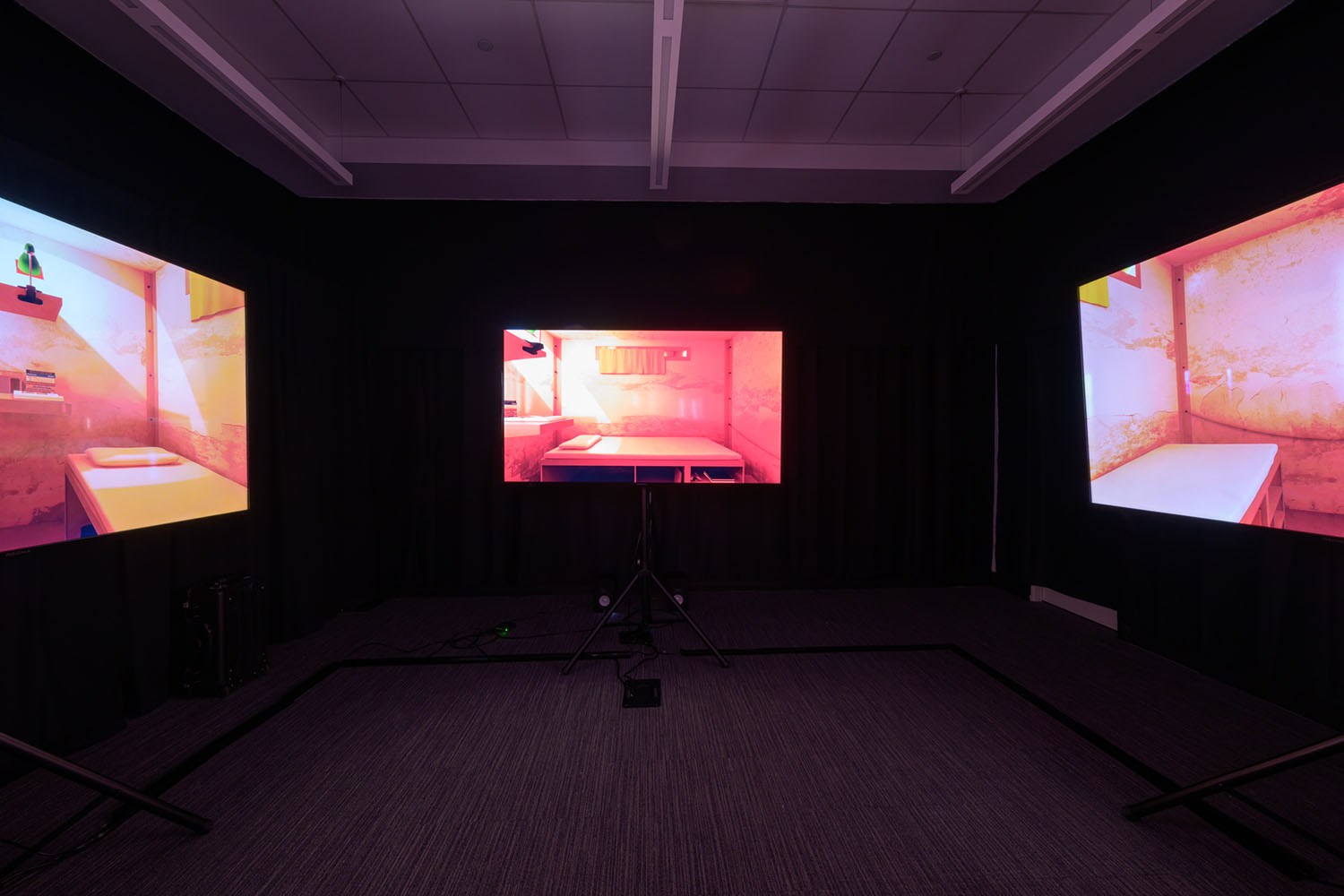
The four-channel video installation surrounds the viewer within the brutal confines of the ten-foot by eight-foot jail cell to vividly portray the suffering experienced by Wells during his incarceration. No Seconds serves as a powerful reminder of the inhumanity perpetuated by the death penalty. Through their collaboration, Dewey-Hagborg and Wells illuminate the intersections of genetics, law enforcement, and systemic discrimination, prompting us to confront the ways in which contemporary society prolongs inequities and injustices. No Seconds serves not only as a memorial to those impacted by the death penalty but also as a catalyst for envisioning a future where every individual is afforded the opportunity for forgiveness and healing, rather than perpetuating an endless cycle of violence.
Rachael Reyes-Vazquez’s Hope for Future Generations is a brightly colored community mural that is informed by her personal lived experience. Having tragically lost her father to a senseless act of gun violence, Reyes-Vazquez brings a profound emotional depth and authenticity to her artistic practice. In the face of this devastating experience, Reyes-Vazquez channels her grief into a powerful call to action, leveraging her art as a vehicle for healing, advocacy, and social change. The collaborative mural project becomes not only a symbol of resilience and hope but also a deeply personal tribute to her father’s memory. It is a demonstration of her unwavering commitment to her own children — and to future generations — to work together to prevent further tragedies. In this context, Reyes-Vazquez’s work resonates with the expressions of grief and resilience found in the art of artists like Frida Kahlo, who transformed her own pain and suffering into works of profound beauty and catharsis. Through Hope for Future Generations, Reyes-Vazquez not only honors her father’s memory but also empowers other families affected by gun violence to find healing and strength in community solidarity, inviting viewers to add to the mural throughout the run of the exhibition.
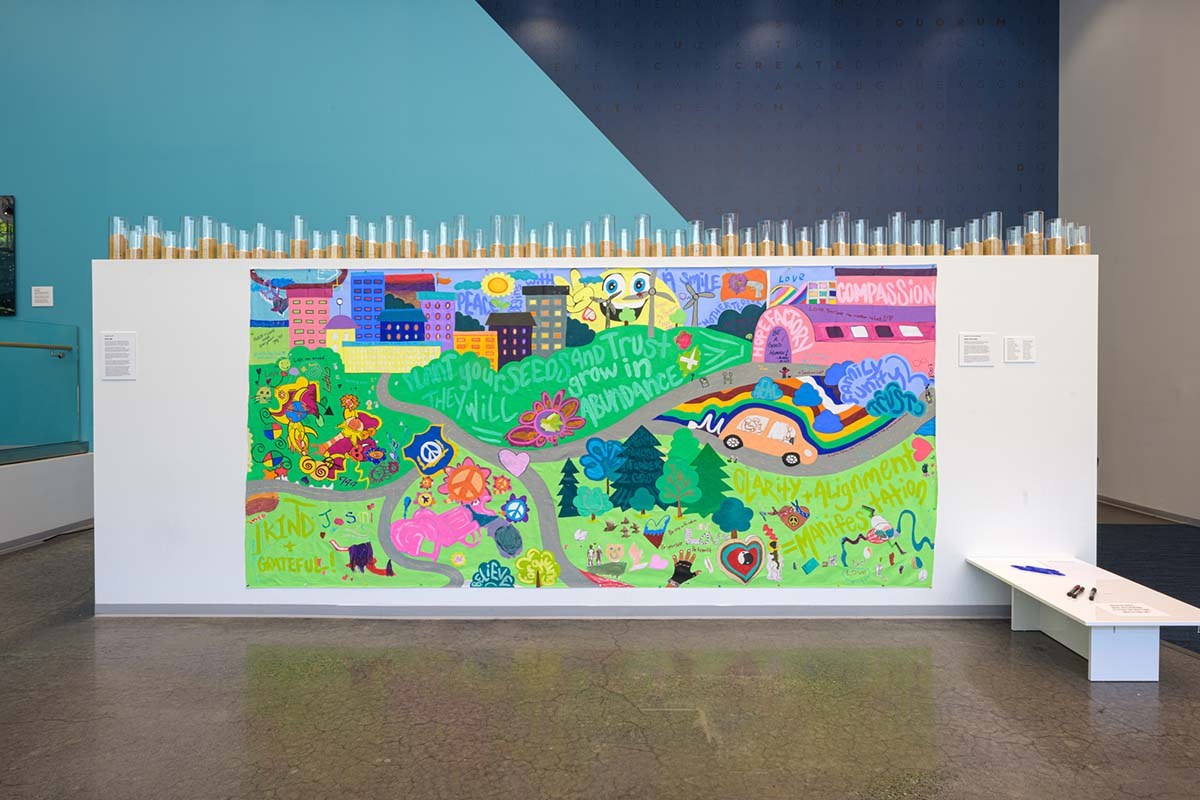
Tim Portlock crafts a vision of a utopian future where violence is a relic of the past in his digital mural Time After the Hunter. This expansive work transports viewers into a futuristic metropolis reminiscent of Philadelphia, where sculptural parks and inviting public spaces represent a historic shift away from a culture of violence. The epic scale of the mural and the use of visual effects software typically employed in film and animation imbues the artwork with a cinematic quality, inviting viewers to picture themselves in Portlock’s imagined world.
Lush greenery and a waterfall dominate the futuristic landscape, inviting contemplation and envisioning a sense of communal serenity. Within the sculptural park, fictional monuments commemorate pivotal moments in America’s journey toward a violence-free existence, serving as beacons of hope and inspiration. Portlock’s mural radiates with an aura of joy and tranquility following a tumultuous and destructive past, encapsulating a collective celebration of utopia. Rather than prescribing a rigid blueprint, Time After the Hunter serves as a catalyst for imaginative exploration, encouraging viewers to envision their own futures devoid of violence and strife.
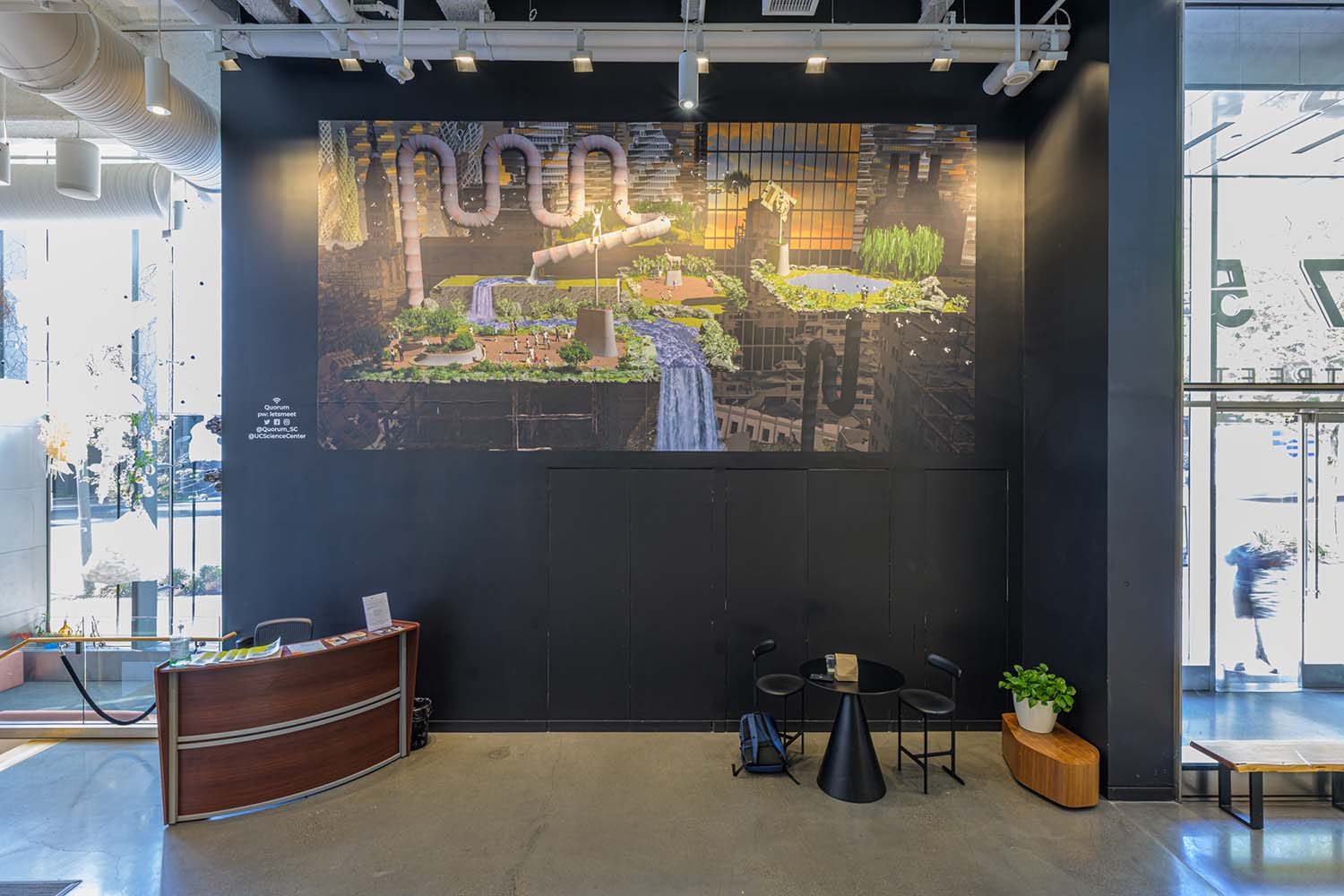
The placement of Portlock’s work, installed high above eye-level and positioned in front of a staircase, enhances the mural’s sense of grandeur and reverence. Placed at such a height, viewers are compelled to look up, their gaze drawn skyward towards the expansive tableau unfolding before them. The mural becomes a modern-day fresco, not bound by the confines of religious iconography, but instead offering a sanctuary for the mind and spirit amidst the chaos of the past.
Oluwafemi’s The Playground in Sunville offers a thought-provoking examination of a near-future society shaped by stringent firearm regulations, inviting viewers into a fictional world where the absence of guns creates both harmony and tension. Through the speculative lens of Sunville, Oluwafemi delves into the complex issues of gun culture from a variety of viewpoints, weaving together threads of historical context, market influences, and societal power dynamics.
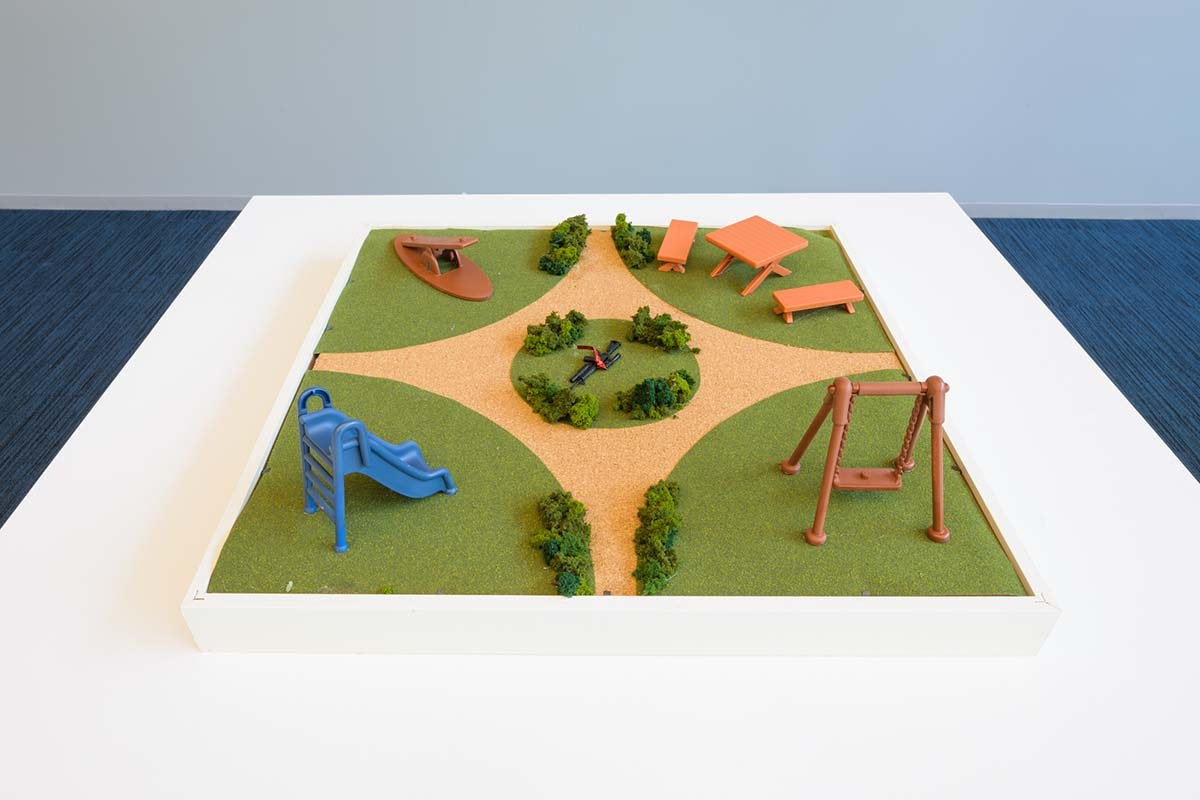
The discovery of a loaded machine gun in a neighborhood playground serves as a stark symbol of the underlying tensions simmering beneath the surface of a seemingly idyllic community. As viewers navigate the intricacies of The Playground in Sunville, they are prompted to confront uncomfortable truths about the pervasive influence of gun culture even as they envision alternative futures grounded in community care and social equity.
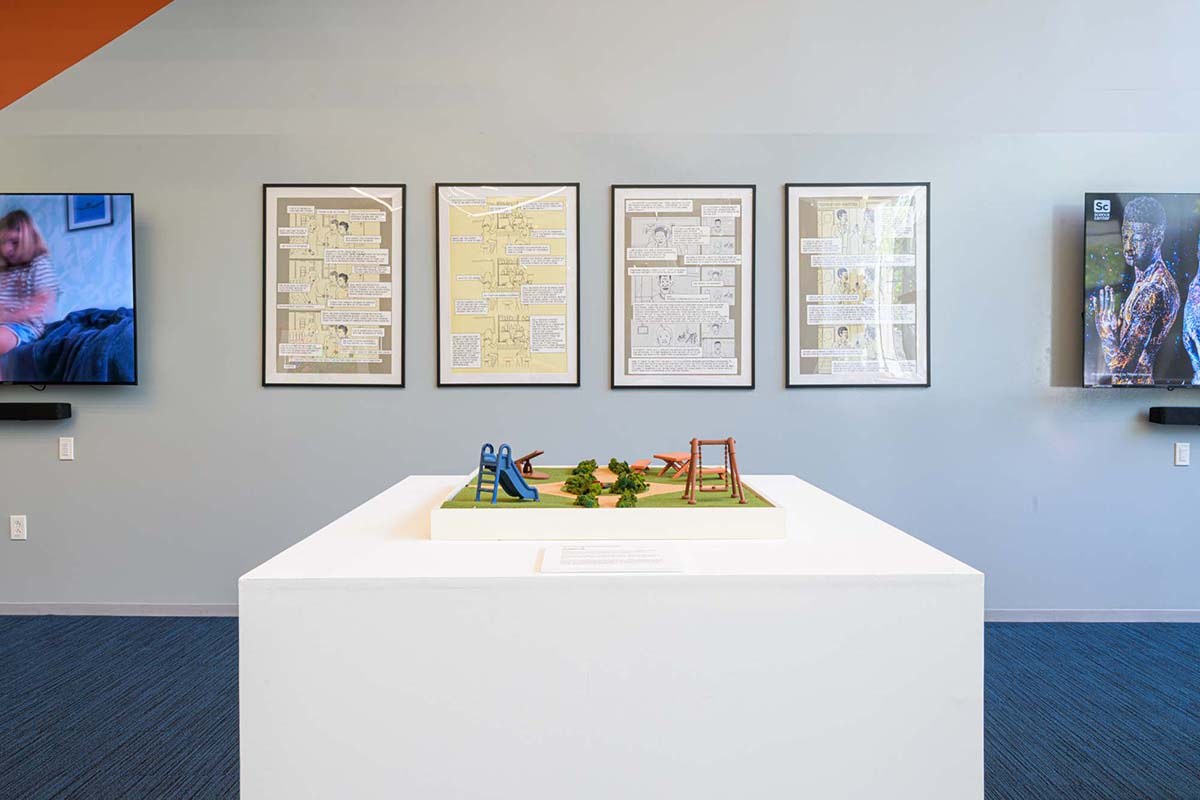
Oluwafemi’s work is based in fiction, but it points to the reality that if a state or city were to successfully outlaw all firearms, the implications would be wide-ranging. On one hand, such a move could lead to a significant reduction in gun-related violence, accidents, and deaths, promoting public safety and well-being. It could also contribute to a shift in societal norms and attitudes towards conflict resolution and community safety, potentially fostering a culture of non-violence and cooperation. However, there are also potential drawbacks and challenges to consider. Critics of firearm bans argue that they could infringe upon individual liberties and rights, sparking legal battles and civil unrest. They voice additional concerns about the effectiveness of such a ban in preventing criminals or illicit groups from obtaining firearms through illegal means, potentially leading to unintended consequences or underground markets for weapons — a situation addressed in Oluwafemi’s work. Ultimately, the feasibility and desirability of implementing a successful ban on firearms in any part of the United States would depend on a complex interplay of legal, political, social, and cultural factors.
Wi-Moto Nyoka’s A Funeral for The Death Machines is a layered, sonic reflection of the transformative power of ritual and music. In this half-hour live performance of an EP written and scored by the artist, Nyoka invites viewers to bear witness to the unique narrative of a gun and a bullet on their final night on Earth. Through a diverse range of musical genres from Gospel to House, Nyoka navigates themes of pride, power, grief, and hope.
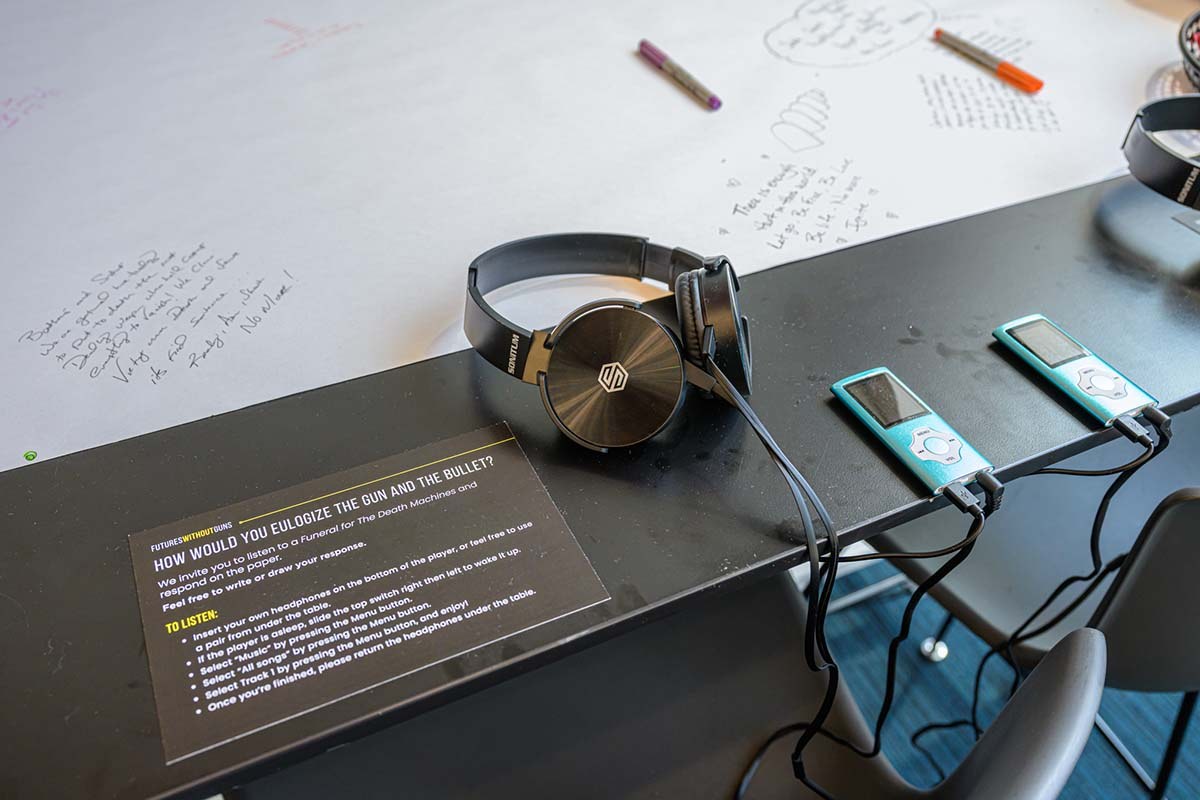
The track list, which includes titles such as Against the Temple and Invincible, bring to light the complex emotions woven into the fabric of gun culture and the human experience. Through A Funeral for The Death Machines, Nyoka confronts the devastating toll of gun violence but also offers a vision of renewal and unity grounded in the symbolic act of melting down weapons to forge a new narrative of peace and healing. As viewers engage with the music, they are invited to participate in the rehearsal of a world liberated from the shadows of weaponry, where the collective voice of the people resounds with the promise of a brighter tomorrow.
Each of the artists featured in Futures Without Guns offers shared
routes towards a solution.
Through their provocative projects, we see clearly where we are and where we need to move towards. Grassroots engagement, continued discussions, and concerted efforts are all vital in preventing the perpetuation of gun violence in the city. In the face of fatigue or disillusionment, maintaining hope and perseverance remains essential for fostering progress and bringing about meaningful change. By working together and remaining steadfast in our commitment to creating safer and more equitable communities, we can pave the way towards a brighter future for all residents.
Together, these artworks are not solutions, but rather stand as poignant reminders, urging us to collectively confront the pressing need for action in addressing the underlying causes of gun violence in our community. They ask viewers to delve into uncomfortable realities and inspire creativity in the contemplation of alternative futures. As visitors immerse themselves in the exhibition, they are not only encouraged to reflect but also to envision a world free from the pervasive threat of firearms. Futures Without Guns is offered as a vessel for introspection and discourse, infused with the hope for a brighter tomorrow.
Through the lens of art, it illuminates the path forward, reminding us that while the journey may be daunting, the possibility of a safer, more harmonious world is indeed within reach — if only we dare to imagine it.
We invite you to join us on for the Closing Reception of Futures Without Guns on Thursday, June 13, from 5:00-8:00pm.



